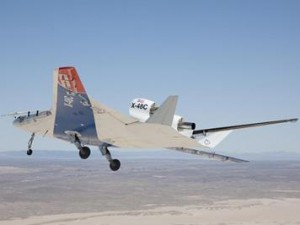
EDWARDS—NASA’s remotely piloted X-48C hybrid-wing-body subscale aircraft, which demonstrates technology concepts for cleaner and quieter commercial air travel, completed an eight-month flight research campaign on April 9.
The C model of the X-48 aircraft flew its first flight at Edwards on Aug. 7 and its 30th flight brought the productive research project to a close.
“We have accomplished our goals of establishing a ground-to-flight database, and proving the low speed controllability of the concept throughout the flight envelope,” said Fay Collier, manager of NASA’s Environmentally Responsible Aviation project. “Very quiet and efficient, the hybrid wing body has shown promise for meeting all of NASA’s environmental goals for future aircraft designs.”
The scale-model aircraft, shaped like a manta ray, was designed by The Boeing Co., built by Cranfield Aerospace Limited of the United Kingdom, and flown in partnership with NASA.

The X-48C is a version of NASA’s X-48B blended wing body aircraft modified to evaluate the low-speed stability and control of a low-noise version of a notional hybrid-wing-body design. This design features a flattened fuselage with no tail, and engines mounted on top of the fuselage at the rear of the plane. The design stems from concept studies for commercial aircraft that could be flying within 20 years. The studies are under way in NASA’s Environmentally Responsible Aviation Project.
“Our team has done what we do best: flight-test a unique aircraft and repeatedly collect data that will be used to design future ‘green’ airliners,” said Heather Maliska, X-48C project manager at NASA’s Dryden Flight Research Center in California.
“It is bittersweet to see the program come to an end, but we are proud of the safe and extremely successful joint Boeing and NASA flight test program that we have conducted,” Maliska added.
The X-48C retained most dimensions of the B model, with a wingspan slightly longer than 20 feet and a weight of about 500 pounds. Primary changes to the X-48C model from the B model, which flew 92 flights at Dryden between 2007 and 2010, were geared to transforming it to an airframe noise-shielding configuration.
External modifications included relocating the wingtip winglets inboard next to the engines, effectively turning them into twin tails. The rear deck of the aircraft was extended about two feet. Finally, the project team replaced the X-48B’s three 50-pound thrust jet engines with two 89-pound thrust engines. The aircraft had an estimated top speed of about 140 mph and a maximum altitude of 10,000 feet.
“Working closely with NASA, we have been privileged throughout X-48 flight-testing to explore and validate what we believe is a significant breakthrough in the science of flight, and this has been a tremendous success for Boeing,” said Bob Liebeck, a Boeing senior technical fellow and the company’s Blended Wing Body (BWB) Program manager. “We have shown a BWB aircraft, which offers the tremendous promise of significantly greater fuel efficiency and reduced noise, can be controlled as effectively as a conventional tube-and-wing aircraft during takeoffs, landings and other low-speed segments of the flight regime.”
“Our goal was to define the low-speed envelope and explore the low-speed handling qualities of the blended wing body class of tailless aircraft, and we have accomplished that,” added Mike Kisska, Boeing X-48 project manager.
Because handling qualities of the X-48C were different from those of the X-48B, the project team modified the flight control system software, including flight control limiters to keep the airplane flying within a safe flight envelope. This enabled a stronger and safer prototype flight control system suitable for future full-scale commercial hybrid or blended wing aircraft.
NASA’s Aeronautics Research Mission Directorate and Boeing funded the X-48 technology demonstration research effort, which supported NASA’s goals of reduced fuel burn, emissions, and noise. The Air Force Research Laboratory in Dayton, Ohio, also was a member of the project team.
For more information about aeronautics research at NASA, visit http://www.aeronautics.nasa.gov. For more about NASA Dryden Flight Research Center, visit http://www.nasa.gov/centers/dryden.
(Information via press release from NASA Dryden Flight Research Center.)
Adam Chant says
It’s called cooperation.. The resources available through NASA are extensive in this field so by sharing the effort more can be accomplished at a lower cost.
You can’t imagine how expensive it is to perform flight test on the range as a commercial vendor like Boeing. NASA has its own facilities and can absorb a large part of that cost as normal operations..
Think of it like a NASCAR sponsorship.. except the guy with the sticker on the vehicle also has an engineering stake in the project..
The bottom line is that it means jobs in the AV no matter who’s name is on the side of the bird..
ts says
Freaking really,,,, the only thing NASA had to do with this project was to house it for Boeing so they could use the Air Space,,, it would figure that Dryden would slap there name to a project that all’s they had to do was collect a fee for Space and Flight Test Range to fly it.
BUT HEY DRYDEN GIVE YOURSELFS A BIG PATT ON THE BACK AND NOT GIVE CREDIT DUE TO WHOM IS DESERVING,,, “BOEING”!!!
frank rizzo says
Agree! NASA is one of those agency that likes to take credit for others work. NASA is a waste of money, the Gov should delete NASA and save money. I am sure Boeing and other companies could test without the AID of NASA.